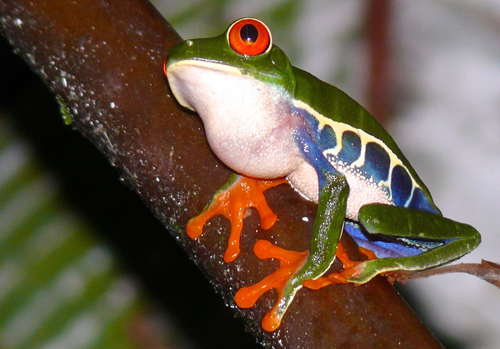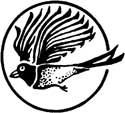To Friday, July 13, 2018
 We invite you to explore Costa Rica’s scenic network of national parks and wildlife preserves from lowland rain forest to the northernmost páramo—or tropical alpine zone—in Central America. A population of nearly 100 Scarlet Macaws inhabits Carara National Park. Carara is also the home of Baird’s Trogons, Fiery-billed Araçaris, Orange-collared Manakins, and perhaps the finest lowland birding in the entire country. At our accommodations adjacent to Carara our groups are frequently treated to Scarlet Macaws flying overhead to roost in the late afternoon. High on the Cordillera Talamanca the Río Savegre has emerged as a reliable location for the Resplendent Quetzal. Past groups have had saturation looks of these fabulous birds, reputedly the most beautiful species in the Western Hemisphere. Aside from quetzals, at the Río Savegre we’ll also search for handsome little Flame-throated Warblers, Long-tailed Silky-Flycatchers, and elusive Wrenthrushes (or Zeledonias). Across the continental divide, Rancho Naturalista is located in the foothills on the southern Caribbean slope. Overlooking the Tuis River Valley, the lodge has earned a reputation as the best location in Costa Rica to see a Snowcap, a deep purple little hummingbird with a white crown and a white tail. It is just one of 15 species of hummingbirds that exploit the Rancho’s feeders and lush plantings. Other birds we may encounter at Rancho Naturalista include Purplish-backed Quail-Dove, Brown-billed Scythebill, Tawny-chested Flycatcher, White-ruffed and White-collared Manakins, and the stunning velvet black-and-crimson red Passerini’s Tanager (half of the former “Scarlet-rumped Tanager” complex). While at the Rancho we’ll also enjoy the throngs of birds patronizing the fruit and rice feeders at sunrise. Great cooking combined with great birding makes the Rancho the perfect base for exploring the bird-rich foothill zone of the Cordillera Central. Some 400 species of birds are known from La Selva field station in the lowland Caribbean rain forest, including Great Tinamou, Great Potoo, Long-tailed Tyrant, Gartered (Violaceous) Trogon, and the beautiful Snowy Cotinga. Many of our groups at La Selva have been rewarded with views of both King Vulture and Great Green Macaw. At the Monteverde Cloud Forest, the “Blue-throated” subspecies of Emerald Toucanets have to compete for attention at this Quaker sanctuary with a rainbow of hummingbirds and gorgeous array of orchids and tree ferns. Including the jewels at Monteverde, past groups have seen a total of over 30 species of hummingbirds along this route. Mealy Parrots, Chestnut-mandibled Toucans, Blue-crowned Motmots, and graceful ballets performed by groups of Swallow-tailed Kites are just a few other examples of the bird riches we can expect on our trip to this enchanting Central American democracy. Approximately 880 species occur here, more than are found in all the United States, Canada, and Alaska combined—although little Costa Rica is only about the land area of two Arizona counties. Mammals we will look for include three kinds of monkeys, Coatis, Kinkajous, Agouti, Collared Peccaries, two different sloths, Southern River Otters, and possibly Tamandua—the Saddle-back Anteater. Ungainly Iguanas are common in the lowlands and American Crocodiles are almost certain near Carara. Approximately 12 percent of Costa Rica has been dedicated to their National Park system, twice the amount protected in the United States. Our tour has been deliberately set during the “off-season” for tourists, when temperatures are 10-15°F cooler than the windy dry season that corresponds to the North American spring. Many of the resident tropical birds will still be breeding and others will be feeding newly fledged young. Our beautiful accommodations vary from backcountry lodges adjacent to parks designed for ecology groups like ours, to modern hotels with full amenities.
We invite you to explore Costa Rica’s scenic network of national parks and wildlife preserves from lowland rain forest to the northernmost páramo—or tropical alpine zone—in Central America. A population of nearly 100 Scarlet Macaws inhabits Carara National Park. Carara is also the home of Baird’s Trogons, Fiery-billed Araçaris, Orange-collared Manakins, and perhaps the finest lowland birding in the entire country. At our accommodations adjacent to Carara our groups are frequently treated to Scarlet Macaws flying overhead to roost in the late afternoon. High on the Cordillera Talamanca the Río Savegre has emerged as a reliable location for the Resplendent Quetzal. Past groups have had saturation looks of these fabulous birds, reputedly the most beautiful species in the Western Hemisphere. Aside from quetzals, at the Río Savegre we’ll also search for handsome little Flame-throated Warblers, Long-tailed Silky-Flycatchers, and elusive Wrenthrushes (or Zeledonias). Across the continental divide, Rancho Naturalista is located in the foothills on the southern Caribbean slope. Overlooking the Tuis River Valley, the lodge has earned a reputation as the best location in Costa Rica to see a Snowcap, a deep purple little hummingbird with a white crown and a white tail. It is just one of 15 species of hummingbirds that exploit the Rancho’s feeders and lush plantings. Other birds we may encounter at Rancho Naturalista include Purplish-backed Quail-Dove, Brown-billed Scythebill, Tawny-chested Flycatcher, White-ruffed and White-collared Manakins, and the stunning velvet black-and-crimson red Passerini’s Tanager (half of the former “Scarlet-rumped Tanager” complex). While at the Rancho we’ll also enjoy the throngs of birds patronizing the fruit and rice feeders at sunrise. Great cooking combined with great birding makes the Rancho the perfect base for exploring the bird-rich foothill zone of the Cordillera Central. Some 400 species of birds are known from La Selva field station in the lowland Caribbean rain forest, including Great Tinamou, Great Potoo, Long-tailed Tyrant, Gartered (Violaceous) Trogon, and the beautiful Snowy Cotinga. Many of our groups at La Selva have been rewarded with views of both King Vulture and Great Green Macaw. At the Monteverde Cloud Forest, the “Blue-throated” subspecies of Emerald Toucanets have to compete for attention at this Quaker sanctuary with a rainbow of hummingbirds and gorgeous array of orchids and tree ferns. Including the jewels at Monteverde, past groups have seen a total of over 30 species of hummingbirds along this route. Mealy Parrots, Chestnut-mandibled Toucans, Blue-crowned Motmots, and graceful ballets performed by groups of Swallow-tailed Kites are just a few other examples of the bird riches we can expect on our trip to this enchanting Central American democracy. Approximately 880 species occur here, more than are found in all the United States, Canada, and Alaska combined—although little Costa Rica is only about the land area of two Arizona counties. Mammals we will look for include three kinds of monkeys, Coatis, Kinkajous, Agouti, Collared Peccaries, two different sloths, Southern River Otters, and possibly Tamandua—the Saddle-back Anteater. Ungainly Iguanas are common in the lowlands and American Crocodiles are almost certain near Carara. Approximately 12 percent of Costa Rica has been dedicated to their National Park system, twice the amount protected in the United States. Our tour has been deliberately set during the “off-season” for tourists, when temperatures are 10-15°F cooler than the windy dry season that corresponds to the North American spring. Many of the resident tropical birds will still be breeding and others will be feeding newly fledged young. Our beautiful accommodations vary from backcountry lodges adjacent to parks designed for ecology groups like ours, to modern hotels with full amenities.
Leaders: Carlos "Charlie" Gómez & John Yerger
Cost of Costa Rica includes all accommodations, all meals, all transportation, and all entrances beginning and ending in San José, Costa Rica—$4495.
Photo: Red-eyed Tree Frog
Photo by: Rick Taylor







